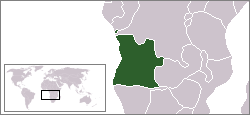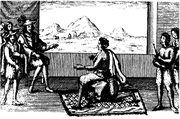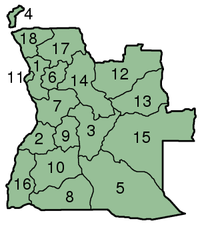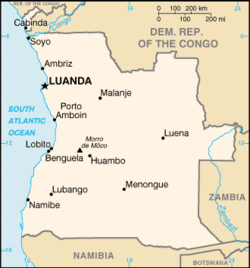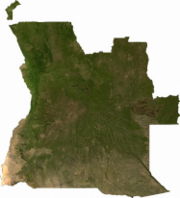Angola
2007 Schools Wikipedia Selection. Related subjects: African Countries; Countries
| República de Angola Republic of Angola |
|||||
|
|||||
| Motto: "Virtus Unita Fortior" ( Latin) "Unity Provides Strength" |
|||||
| Anthem: Angola Avante! (Portuguese) "Forward Angola!" |
|||||
| Capital (and largest city) |
Luanda |
||||
| Official languages | Portuguese | ||||
|---|---|---|---|---|---|
| Government | Multi-party democracy | ||||
| - President | José E. dos Santos | ||||
| - Prime Minister | Fernando da Piedade Dias dos Santos |
||||
| Independence | from Portugal | ||||
| - Date | November 11, 1975 | ||||
| Area | |||||
| - Total | 1,246,700 km² ( 23rd) 481,354 sq mi |
||||
| - Water (%) | negligible | ||||
| Population | |||||
| - 2005 estimate | 15,941,000 ( 61st) | ||||
| - 1970 census | 5,646,166 | ||||
| - Density | 13/km² ( 199th) 34/sq mi |
||||
| GDP ( PPP) | 2005 estimate | ||||
| - Total | $43.362 billion ( 82nd) | ||||
| - Per capita | $2,813 ( 126th) | ||||
| HDI (2004) | |||||
| Currency | Kwanza ( AOA) |
||||
| Time zone | WAT ( UTC+1) | ||||
| - Summer ( DST) | not observed ( UTC+1) | ||||
| Internet TLD | .ao | ||||
| Calling code | +244 | ||||
Angola is a country in south-central Africa bordering Namibia, the Democratic Republic of the Congo, and Zambia, and with a west coast along the Atlantic Ocean. The exclave province Cabinda has a border with Republic of the Congo. A former Portuguese colony, it has considerable natural resources, among which oil and diamonds are the most significant. The country is nominally a democracy and is formally named the Republic of Angola (Portuguese: República de Angola, pronounced IPA: [ʁɛ'publikɐ dɨ ɐ̃'gɔlɐ]).
History
The earliest inhabitants of the area were Khoisan hunter-gatherers. They were largely replaced by Bantu tribes during Bantu migrations. In present-day Angola, Portugal settled in 1483 at the river Congo, where the Kongo State, Ndongo and Lunda existed. The Kongo State stretched from modern Gabon in the north to the Kwanza River in the south. In 1575 Portugal established a colony at Luanda based on the slave trade. The Portuguese gradually took control of the coastal strip throughout the 16th century by a series of treaties and wars forming the colony of Angola. The Dutch occupied Luanda from 1641- 1648, providing a boost for many African states opposed to the Portuguese.
Colonial era
In 1648 Portugal retook Luanda and initiated a process of reconquest of lost territories, which restored the preoccupation possessions of Portugal by 1650. Treaties regulated relations with Kongo in 1649 and Njinga's Kingdom of Matamba and Ndongo in 1656. The conquest of Pungo Andongo in 1671 was the last great Portuguese expansion, as attempts to invade Kongo in 1670 and Matamba in 1681 failed.
Portugal expanded its territory behind the colony of Benguela in the eighteenth century, and began the attempt to occupy other regions in the mid-nineteenth century. The process resulted in few gains until the 1880s. Full Portuguese administrative control of the interior didn't occur until the beginning of the 20th century. In 1951 the colony was restyled as an overseas province, also called Portuguese West Africa.
Portugal had had a colonial presence in Angola for nearly 500 years, and the population's initial reaction to calls for independence was mixed.
Independence
After the overthrow of fascist Portugal's government by a socialist-inspired military coup, Angola's nationalist parties began to negotiate for independence in January 1975. An agreement was reached with the Portuguese government, with independence to be declared in November 1975. Almost immediately, a civil war broke out between MPLA, UNITA and FNLA, exacerbated by foreign intervention. Upon independence from Portugal in 1975, Angola's capital and nominal government came under the one-party rule of the Popular Liberation Movement.
In order to defend the 1,376-kilometer Angolan border with its South West Africa possession against infiltration by South West Africa People's Organization (SWAPO) guerrillas based in Angola, South African forces cleared a one-kilometer-wide strip in Angola along nearly half the border's length. Zaire, which had provided support to FNLA guerrillas, soon began to furnish support for UNITA as well. In turn, the Soviet Union began to significantly increase military aid to MPLA, providing armored vehicles, aircraft, and advisors, while large numbers of Cuban troops were airlifted by Soviet transport planes into Angola in an undisguised effort to tip the military balance in favour of the MPLA. By October 1975, MPLA and Cuban forces took control of Luanda, and much of the country's infrastructure, forcing UNITA forces to revert to guerrilla actions. The MPLA declared itself unilaterally to be the de facto government of the country when independence was formally declared in November, with Agostinho Neto as the first President.
In 1976, the FNLA was defeated by Cuban troops, leaving the MPLA and UNITA (now backed by the United States and South Africa) to fight for power. Since 1979, Jose Eduardo dos Santos has been in control of the country's political leadership. Despite the introduction of a multi-party system in 1991, the Popular Liberation Movement-Labour Party has remained in power.
Civil war
The conflict between MPLA and UNITA raged on in the countryside, fuelled by the geopolitics of the Cold War and by the ability of both parties to access Angola's natural resources. The MPLA drew upon the revenues of off-shore oil resources, while UNITA accessed alluvial diamonds that were easily smuggled through the region's very porous borders (LeBillon, 1999).
In 1991, the factions agreed to the Bicesse Accords which were intended to convert Angola from a one-party authoritarian government into a multiparty state with democratic elections in 1992. President dos Santos led the first round of the election with more than 49% of the vote to Jonas Savimbi's 40%. After claims of fraud, civil war again broke out, and the final runoff election never took place.
A 1994 peace accord (Lusaka protocol) between the government and UNITA provided for the integration of former UNITA insurgents into the government. A national unity government was installed in 1997, but serious fighting resumed in late 1998, rendering hundreds of thousands of people homeless. President dos Santos once again suspended moves towards a unity government. Despite the promise of a democratically-elected government and a multi-party system, the Popular Liberation Movement-Labour Party has remained in power.
Ceasefire with UNITA
On February 22, 2002, Jonas Savimbi, the leader of UNITA, was killed in combat with government troops, and a cease-fire was reached by the two factions. UNITA gave up its armed wing and assumed the role of major opposition party. Although the political situation of the country began to stabilize, President dos Santos has so far refused to institute regular democratic processes. Among Angola's major problems are a serious humanitarian crisis (a result of the prolonged war), the abundance of minefields, and the actions of guerrilla movements fighting for the independence of the northern exclave of Cabinda ( Frente para a Libertação do Enclave de Cabinda).
Angola, like many sub-Saharan nations, is subject to periodic outbreaks of infectious diseases. In April 2005, Angola was in the midst of an outbreak of the Marburg virus which was rapidly becoming the worst outbreak of a haemorrhagic fever in recorded history, with over 237 deaths recorded out of 261 reported cases, and having spread to 7 out of the 18 provinces as of April 19, 2005.
Politics
Angola's motto is "Virtus Unita Fortior", a Latin phrase meaning "Unity Provides Strength".
The executive branch of the government is composed of the President, the Prime Minister (currently Fernando da Piedade Dias dos Santos) and Council of Ministers. Currently, political power is concentrated in the Presidency. The Council of Ministers, composed of all government ministers and vice ministers, meets regularly to discuss policy issues. Governors of the 18 provinces are appointed by and serve at the pleasure of the president. The Constitutional Law of 1992 establishes the broad outlines of government structure and delineates the rights and duties of citizens. The legal system is based on Portuguese and customary law but is weak and fragmented, and courts operate in only 12 of more than 140 municipalities. A Supreme Court serves as the appellate tribunal; a Constitutional Court with powers of judicial review has never been constituted despite statutory authorization. Critics have drawn an ironic comparison between Angola's current one-party rule and the authoritarian regime of António de Oliveira Salazar of Portugal, under whose rule Angolans began their revolt for independence so many years ago.
The 27-year long Angolan Civil War ravaged the country's political and social institutions. The UN estimates of 1.8 million internally displaced persons (IDPs), while generally the accepted figure for war-affected people is 4 million. Daily conditions of life throughout the country and specifically Luanda (population approximately 4 million) mirror the collapse of administrative infrastructure as well as many social institutions. The ongoing grave economic situation largely prevents any government support for social institutions. Hospitals are without medicines or basic equipment, schools are without books, and public employees often lack the basic supplies for their day-to-day work.
The current government has announced an intention to hold elections in 2006. These elections would be the first since 1992 and would serve to elect both a new president and a new National Assembly.
Administrative divisions
Angola is divided into eighteen provinces (províncias) and 158 municipalities (municípios). The provinces are:
|
1 Bengo |
7 Cuanza Sul |
13 Lunda Sul |
|
Geography
At 481,321 mi² (1,246,700 km² ), Angola is the world's twenty-third largest country (after Niger). It is comparable in size to Mali and is nearly twice the size of the US state of Texas.
Angola is bordered by Namibia to the south, Zambia to the east, the Democratic Republic of the Congo to the north-east, and the South Atlantic Ocean to the west. The exclave of Cabinda also borders the Republic of the Congo to the north. Angola's capital, Luanda, lies on the Atlantic coast in the north-west of the country. Angola's average temperature on the coast is 60 degrees Fahrenheit (16 °C) in the winter and 70 degrees Fahrenheit (21 °C) in the summer.
Economy
Angola's economy has undergone a period of transformation in recent years, moving from the disarray caused by a quarter century of war to being the fastest growing economy in Africa and one of the fastest in the world. In 2004, China's Eximbank approved a $2 billion line of credit to Angola. The loan is being used to rebuild Angola's infrastructure, though it has also limited the influence of the International Monetary Fund in the country. Growth is almost entirely driven by rising oil production which surpassed 1.4 million barrels per day in late-2005 and which is expected to grow to 2 million barrels per day by 2007. Control of the oil industry is consolidated in Sonangol Group, a conglomerate which is owned by the Angolan government. The economy grew 18% in 2005; growth is expected to reach 26% in 2006 and stay above 10% for the rest of the decade. The security brought about by the 2002 peace settlement has led to the resettlement of 4 million displaced persons, thus resulting in large-scale increases in agriculture production. With revenues booming from oil exports, the government has started to implement ambitious development programs in building roads and other basic infrastructure for the nation.


